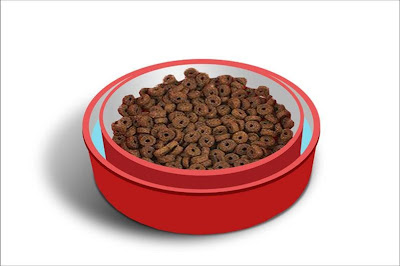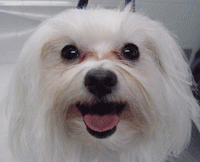 Part of the Pet Net Safety Event
Part of the Pet Net Safety EventWe've all heard that chocolate is bad for our furry friends, but there are many other everyday foods that could be potentially harmful to our pets. Americans spend over $10 billion dollars on pet food and despite buying the best food available, some pets would rather eat what we eat. But beware as certain foods can be dangerous to your pet.
-Alcoholic Beverages. Ethanol is the component in alcoholic beverages that can be toxic when an excessive amount is ingested. Pets are much smaller than us and can be highly affected by small amounts of alcohol.
-Apples, Apricots, Cherries, Peaches and Plums. Ingestion of large amounts of stems, seeds and leaves of these fruits can be toxic. They contain a cyanide type compound and signs of toxicity include apprehension, dilated pupils, difficulty breathing, hyperventilation and shock.
-Avocados. The leaves, fruit, bark and seeds of avocados have all been reported to be toxic.
-Baking Powder and Baking Soda. Baking soda and baking powder are both leavening agents - It produces a gas causing batter and dough to rise. Baking soda is simply sodium bicarbonate. Baking powder actually consists of baking soda and an acid. Could lead to congestive heart failure or muscle spasms.
-Chocolate - Depending on the type of chocolate ingested and the amount eaten, various problems can occur. The high fat content in chocolate may result in vomiting and possibly diarrhea. You may notice restlessness, hyperactivity, muscle twitching, increased urination and possibly excessive panting. Heart rate and blood pressure levels may also be increased. Seizure activity may occur in severe cases.
-Coffee (grounds and beans). Dogs that eat coffee grounds or beans can get "caffeine" toxicity.
-Fatty Foods. Rich and fatty food are favorites of dogs. They often get them as treats, leftovers or from getting into the trash. These fatty foods can cause pancreatitis. Pancreatitis can affect any pet. Miniature or toy poodles, cocker spaniels and miniature schnauzers are particularly prone. Signs of pancreatitis generally include an acute onset of vomiting, sometimes diarrhea and abdominal pain.
-Dairy Products. Dairy products are not highly dangerous but can pose problems for two reasons. One is their high fat content. The second reason is that pets poorly digest dairy products since they lack the enzyme required to digest lactose.
-Grapes and Raisins. Any dog that ingests large amounts of grapes or raisins should be treated aggressively, so contact your veterinarian immediately if ingestion has occurred.
-Macadamia Nuts. Macadamia nuts, also called the Queensland nut or Australia nut, can be toxic. The mechanism behind why these nuts are toxic is a mystery. Dogs develop weakness, depression, vomiting, difficulty walking, tremors, abdominal pain, lameness, stiffness and/or pale gums. The signs usually dissipate in 12 to 24 hrs.
-Moldy or Spoiled Food. Dogs love to get into the trash. In addition to food poisoning, some pets can develop tremors related to the ingestion of certain molds.
-Nutmeg. You may not realized this but high levels of nutmeg can be toxic, even fatal. Signs of toxicity include tremors, seizures, nervous system abnormalities or death.
-Onions or Garlic. Dogs and cats lack the enzyme necessary to properly digest onions and this could result in gas, vomiting, diarrhea or severe gastrointestinal distress.
All forms of onion and garlic are a problem. This includes raw, dehydrated, cooked, powders or those in foods.
-Yeast Dough. When ingested, bread or yeast dough will "rise" in the stomach just as it would for bread. As the dough rises and ferments, alcohol is produced. There are two problems with yeast dough. The biggest problem is that the dough often rises to many times its size, expanding the pet's stomach. The second problem is from the alcohol component, which can cause "alcohol toxicity."
-Cooked bones - Your pet does not have to give up their favorite raw bones, but they do need to give up any cooked bones they have. Cooked bones can become brittle, and because of this they can shatter and cause severe injury to the lining of the digestive track.
-Everday Toxins in the Home - Beware of everyday toxins that your pets can get into, including cleaning supplies, beauty products and even antifreeze. The smells of these items may attract your pets, but it is important to keep them away to avoid any issues.
-Beware of other pet wastes - Yes, some pets like to eat their own wastes, and sometimes the wastes of other pets. This one sure way for a pet to be at risk for diseases and parasites, which can make your dog ill. One such parasite, called Giardia,is transmitted from one dog to another through the ingestion of cysts in contaminated feed, drinking water or feces.
-Pet food not meant for your pet - in other words, dogs should only eat dog food, not cat food or any other pet food. Foods are specifically formulated for that particular animal and could be harmful to other pets because it won't have the right balance of proteins, vitamins and other minerals that your pet needs.
- Raw Salmon - It is thought that raw salmon and trout could carry a parasite that is potentially fatal to pets. The parasite has little effect on the fish itself, but if ingested by a dog, could cause serious problems.
These are just some of the everyday items to be avoid, but as always, check with your vet before giving your pets any type of diet that involves "people food."
Resources:
www.thepetplace.com
SeniorPetProducts.com
http://www.vetinfo.com/dtoxin.html


 Falar sobre alimentação, mais especificamente de ração para cães e gatos pode parecer um tema bastante simples, afinal estamos falando de uma embalagem que se compra em pet-shop ou supermercado e já vem pronta para servir. Na verdade não é bem assim, afinal aquela prateleira está cheia de tipos diferentes de rações, qual será a mais indicada para meu cão?
Falar sobre alimentação, mais especificamente de ração para cães e gatos pode parecer um tema bastante simples, afinal estamos falando de uma embalagem que se compra em pet-shop ou supermercado e já vem pronta para servir. Na verdade não é bem assim, afinal aquela prateleira está cheia de tipos diferentes de rações, qual será a mais indicada para meu cão?  Part of the Pet Net Safety Event
Part of the Pet Net Safety Event




















